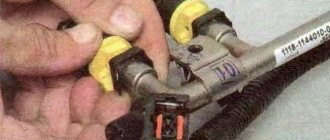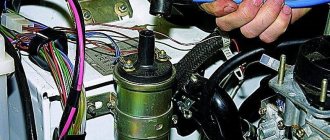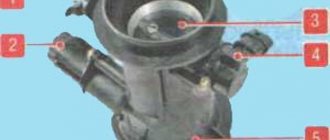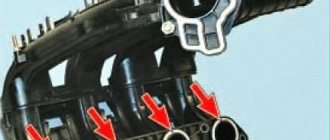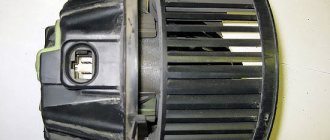Have you encountered engine problems when the car stalls in traffic jams or the engine speed is unstable? There may be several reasons for these malfunctions. It is recommended to start searching for a problem with diagnostics, and if this is not possible, then first perform a check, and only then change the faulty parts.
AvtoVAZ installs the same type of engines on modern Lada cars (Kalina, Granta, Priora, Largus, Vesta, Niva or XRAY), so the solution to problems for all these cars is similar.
The idle speed fluctuates, the engine stalls when moving (on the move) or at a standstill, the reasons may be the following:
- The engine air filter is clogged.
- The spark plugs are faulty.
- High voltage wires are faulty.
- Ignition module/coils are faulty.
- The idle air control (IAC) or its electrical circuits are faulty.
- The throttle position sensor (TPS) is faulty or the throttle assembly is dirty.
- The mass air flow sensor (MAF) is not working.
- The oxygen sensor (OS) or circuits are faulty.
- There is insufficient pressure in the fuel rail.
- Compression in the cylinders is low.
- The exhaust system is leaking.
- Air leaks through the crankcase ventilation hoses and the hose connecting the intake pipe to the vacuum brake booster.
- The cylinder head gasket is damaged.
- The timing belt or tension roller is worn.
- The camshaft cams are worn.
- The valve timing is off. Check the alignment of the marks on the crankshaft and camshaft.
- The engine control unit (ECU) or its circuits are faulty.
Have you encountered floating engine speeds? What was the cause of the malfunction? We solve such engine problems in the comments or on the forum. Let us remind you that along with unstable speed there may be other problems, for example, the engine is difficult to start.
This article will talk about why the car stalls while driving. The reason for this phenomenon may be the most banal, but you will get a lot of troubles from such “behavior” of the car. In addition, the engine may stall at idle speed. This is not very pleasant; the engine seems to start, but after a while it stops working. It is possible that the engine does not want to start if its temperature is close to operating temperature. The operating temperature of the engine is about 90 degrees. And there can be many reasons, but we need to consider the main ones.
Why do the revs fluctuate on the Lada Largus?
According to reviews, the problem with floating engine speeds is familiar to many Lada Largus owners. This is especially true in winter, when the car has difficulty starting when cold (starting the engine is difficult in the morning). In such situations, floating speeds only make the situation worse. The tachometer needle may jump chaotically from 1000 to 1500 rpm or not reach the “warm-up” level at all, staying below the required idle speed values. Experts do not recommend self-diagnosis of the car. If the cause of the problem is unknown, it is better to contact a service station.
Causes and methods of eliminating difficult engine starting
To successfully start the engine, the fuel mixture and a spark from the spark plugs must simultaneously appear in its cylinders.
The engine cannot be started if one or more elements are faulty. This happens, for example, when the starter does not spin the crankshaft.
If floating idle speeds have become too annoying, and it is no longer useful to turn the engine with the starter, it’s time to understand the causes of the malfunctions that have arisen. The table shows the most common reasons why the Lada Largus engine speed fluctuates and it may not start.
Stalls in wet weather
With the onset of autumn and, consequently, an increase in environmental humidity, the engine begins to operate unstably and begins to stall at idle speed. However, it is worth noting that immediately after warming up the problem disappears.
The largest number of experts, answering this question, agree that high-voltage wires and glow plugs become damp, causing all contacts to work when exposed to excess moisture.
In addition, this problem occurs when the ignition coil is faulty and the housing has cracks, into which excess moisture gets in (in the video above, it is worth noting that if a similar problem does not occur in the rain, then this is not the reason).
The cause of a stalled engine is the spark plugs
In 50% of cases, the problem is due to the fact that the spark plugs simply do not produce a spark. This failure occurs as a result of 3 reasons:
- contacts become clogged;
- plaque forms along the entire contour of the candle;
- malfunction when supplying voltage to the spark plug.
However, the most popular is still black carbon deposits on the spark plugs, which prevents the spark from appearing or causes it to work periodically.
Tip: if the spark plug set malfunctions, you will hear a “triple” sound that is uncharacteristic of the engine. In this case, the car will jerk strongly while moving. As a result, the engine will either stall on its own, or you will need to turn it off and turn the ignition on again.
If you see dirt on the surface of the contacts, this indicates the need to replace a low-quality type of fuel or check the serviceability of the oil supply systems. It is the oil supply adjustment sensors that can splash the spark plugs with it if there is a problem. Also, oil that appears on a set of spark plugs may indicate serious damage to components in the engine cylinders. Be sure to check the engine at a car service center. Otherwise, further operation may lead to expensive replacement of jet rods and even the entire set of pistons.
If you systematically use low-quality gasoline samples, you may find a red-brown coating on the contour of the spark plug. In this case, cleaning will not help - it is better to immediately replace the entire set after a new refill. If you find that the car periodically turns off at full speed, but starts easily even with clean spark plugs, then the problem lies in the electrical wiring.
Why Renault Logan starts and immediately stalls or good reasons for unstable idle
The failure of computer diagnostics prompts us to try all sorts of options. Who changes the ignition coil on eight-valve engines of 1.4 or 1.6 liters, in addition throwing away the old spark plugs, and who considers it necessary to change the fuel filter, although the car behaves quite adequately at operating speeds and fuel consumption is within acceptable limits.
The engine control unit
If the Renault Logan ECU is not working correctly, it starts and stalls when cold - this fact is confirmed even by official dealerships. It's not a matter of powering the computer at all - the block and ground are securely fixed. The functional features of the control program raise doubts.
If spontaneous engine shutdown occurs only at near-zero temperatures or in humid weather, you can be sure that the software does not meet operational requirements. “Raw” factory firmware often incorrectly recognizes sudden changes in ambient temperature and humidity.
In 2008, this problem was especially pressing. Then the model was transferred to Euro 3, and computers were installed from Euro 2, but with new firmware. As a result, the engine was unstable not only at idle, but also in many operating modes. It was not possible to resolve the issue at the dealership and there was only one option left - to install software from Paulus.
Canister valve
The task of the valve mechanism is to open the flow of fuel vapor into the intake manifold at certain operating conditions. As a rule, additional injection is carried out at medium speeds of a fully warmed-up engine. If the regulator is faulty, steam is injected at any position of the tachometer needle and at XX in particular.
The following method will help you verify that the valve is working properly:
- Pinch the hose with pliers or remove it from the intake manifold and plug the hole in the latter.
- Start the engine.
- Analyze behavior at idle.
Smooth operation of the power unit after such manipulations indicates a malfunction of the adsorber valve mechanism.
Idle speed control
The IAC regulates the volume of air entering the cylinders when the throttle valve is closed.
Over time, the valve stem becomes dirty, and the idle speed gradually decreases. This is especially true in cold weather, when a dirty regulator begins to perform unusually poorly. As it warms up, the situation changes, because the motor functions more stable. If the mechanism were faulty, the engine would not start without the accelerator being pressed. Therefore, in the case under consideration, there is no need to change the IAC. But it won’t hurt to clean the channel and the sensor itself with carburetor cleaner.
Car engine modifications and their features
The reasons why the speed may fluctuate on Largus are due to differences in the technical characteristics of the engines. Depending on the configuration, an 8- or 16-valve engine is installed.
8-valve K7M 800
This engine model was borrowed from Renault Logan and Sandero. Such motors have been installed on Largus since 2010. The unit complies with the Euro-4 standard, its power is 83 hp. With. Among the disadvantages:
- floating idle speed;
- high fuel consumption;
- lack of hydraulic compensators in the valve mechanism - the gaps need to be adjusted every 30,000 km;
- the need to replace the timing belt every 60,000 km - a broken belt will inevitably lead to bending of the valves;
- unreliability of crankshaft oil seals;
- vibration and increased noise during operation of the power unit.
The 8-valve engine is too weak for Largus. Among the advantages are the unpretentiousness of the engine and its inexpensive maintenance.
16-valve K4M
This engine is used only in the top modifications of Largus in the “Lux” configuration. Engine power is 106 hp. s, but it still requires improvements. It differs from the previous unit:
- absence of vibration and almost complete absence of noise;
- low fuel consumption.
The disadvantage of the 16-valve engine can be considered its complex design, which leads to the high cost of the car. The engine life is about 450,000 km, but servicing the unit is more expensive. The main thing is not to use it often under increased loads and undergo maintenance on time.
Tips to make diagnosis and repair easier
To diagnose a malfunction in a Lada Largus car, you may need special tools and devices. If there are problems with the fuel supply, it is necessary to measure the pressure in the fuel rail; for this you will need a special pressure gauge with an adapter. If it is missing, you can unscrew the gasoline supply hose from the rack, lower it into an empty container, turn on the ignition and measure how many liters of fuel the pump will pump in one minute. A working Lada Largus pump pumps approximately one and a half liters of fuel in one minute.
The performance of the crankshaft position sensor can be checked using an ohmmeter - a device that shows electrical resistance. The working sensor has a resistance of about 250 Ohms, and when a piece of metal approaches the sensor, this value should change.
The presence of a spark can be easily checked by removing the high-voltage wire or ignition coil from the spark plug and bringing the contact closer to a distance of 2-3 mm to the iron element of the engine. When starting the internal combustion engine, an electric charge - a spark - will jump between the wire/coil and the motor element. During the procedure, you must use special insulating gloves or tools.
The cause of a stalled engine is a power supply failure
In this type of problem, 3 reasons may be involved:
- Poor contact with the terminals of the new battery;
- Detection of poor contact or breakdown along the entire length of high-voltage wires;
- The appearance of malfunctions in the generator or ignition coil system of the car.
If the problem lies in damp high-voltage wires, then it is best to replace them completely along with the battery contacts. If the terminals make poor contact, you need to carefully clean them with sandpaper and try to reconnect them. If the generator is found to be inoperable, the problem usually boils down to problems in the following parts:
- Broken timing belt;
- There is a malfunction inside the housing of the unit itself.
A problem with the generator is easily detected when the corresponding indicator on the dashboard turns on. In addition, if there is insufficient energy supply, the backlight of the on-board panel will gradually fade, and a set of other diagnostic sensors will show incorrect values.
Advice: if when you press the gas the car jerks, then stalls and cannot start, then the problem is related to the failure of the ignition coils. It is best to replace these parts in a car service using special equipment.
From the list of reasons that are directly related to the car engine, you need to move on to problems that arise in the fuel and air supply systems, as well as malfunctions of components responsible for exhaust gas removal.
The required amount of fuel is not supplied
Most likely, the problem lies in the pump, which in the vast majority of cars is located in the fuel tank. This pump either fails or its fine mesh becomes clogged.
- Read about replacing the fuel pump
There may be a lot of debris and water in the fuel tank. The mesh catches and delays all this, acting as a filter. In the warm season, all this debris does not interfere with the normal circulation of fuel; it easily enters the combustion chamber. But in winter there is a different picture. In cold weather, water and debris freeze to the mesh rods, and fuel can no longer pass through the mesh at the required speed. And if you manage to pump a little more to start the engine, then you can’t get it to work! Actually, for this reason the engine stalls. Cleaning the mesh is not difficult - the main thing here is to get to the fuel pump.
Finding out the cause of the problem
Now let's figure out how to quickly find out:
- The performance of the fuel pump, of course, is determined by its sound. If there is no sound, then check the wiring and provide 12 V supply to it. Pay attention to the pressure in the fuel system, it should be within 2 - 3 bar while the pump is running. If the fuel supply is stopped, the pressure in the system does not drop immediately. If the pressure drops sharply and there are no fuel leaks, then pay attention to the fuel pressure regulator. At least it can be silenced for a short time.
- Checking the ignition. To avoid burning the ECU, the spark plug must be connected to ground as best as possible.
- When checking the synchronization sensor, first of all, we pay attention to the integrity of the wiring and its shielding.
- As for the ECU, you need to try to move all possible connections. There is a high probability that something has come loose somewhere.
- Notice if the Check Engine light is on. If it lights up, then all is not lost and the ECU is still working. You need to know that it is not yet possible on VAZ cars without a tester to find out the error code and identify the location of the fault.
- If a suspiciously large number of error codes are displayed, then you need to pay attention not to the sensors, but to the fact that some part of your car has completely disappeared.
- You should also pay attention to the performance of the crankshaft synchronization sensor and the performance of the injector control system. But all this requires a special tester, and rarely does anyone carry this device with them in their car. Yes, and it is advisable for specialists to perform such work.
- But many people can check the voltage in the network. As a rule, when the engine is running it should be 14 V, when starting the engine 8 V, and when the engine is not running 12.5 V.
- Be sure to check the integrity of the camshaft drive belt and pulley. It's not hard to do.
- And the last hope. We disconnect everything possible from the ECU (electronic control unit), only leaving the crankshaft synchronization sensor. But again, if you know what you're doing. If you don't know, it's better not to interfere.
The engine still starts, but it is problematic:
- Check the air filter for clogging. If you have completely forgotten where it is, then everything is clear. Go ahead, buy a new filter, or at least clean the old one.
- Check the fuel pump as described above.
- When starting the engine, depress the clutch, this will make starting easier.
- Pay attention to what temperature the coolant sensor shows and what it actually is. Deviations should be within 5, 6 degrees.
- Again, check the car's voltage. What voltage should be, see above, paragraph 8.
- Pay attention to the quality of the fuel. Ask yourself the question, “Where did I refuel today?”
- We move all possible connectors. It’s corny, but sometimes it helps.
- We look at the camshaft drive belt.
These are the simplest actions that are available to many drivers. To conduct a more detailed diagnosis of the cause of poor engine starting, of course, it is better to contact a car service center. Professional equipment and devices will already be used there.
How it manifests itself
When the Renault Logan engine starts and immediately stalls and the reasons are unknown, it is important to pay attention to the operation of the power unit and make adjustments to it. The picture of painful functioning after a long stay is as follows:
- The key moves to the ignition position.
- The system successfully passed the diagnostics - the immobilizer indicator went out, the battery charge lamp and the oil can remained on.
- Turning the key to the starter crank position.
- The engine starts instantly, the tachometer needle sharply reaches 1,500-2,000 rpm and smoothly drops to 500 rpm. Then the unit, choking, stalls.
Usually the next start is accompanied by a similar reaction, but the duration of the starter operation is longer. In other words, there is a reluctance to restart. A boost of gas often helps restore smooth operation. However, you should not regard it as medicine No. 1 - the problem changes dynamically over time and tomorrow pressing the accelerator may not help.
Experts, upon seeing a car with such a breakdown, immediately turn off the power to the coolant temperature sensor. It helps, but does not at all indicate that the sensor is defective. If there are no problems with the hot one, then it’s worth replacing. Otherwise, a change rarely helps.
The price of the sensor is not so high - the original will cost 600-700 rubles, and the model from Luzar is even cheaper - about 300 rubles. It’s better not to start the cooling system at all, otherwise the problem will gradually progress to the stage of impossibility of starting. Then the Renault Logan does not start, and the starter turns unsuccessfully.
For your information. The situation when the sensor is turned off can be commented on as follows: the computer goes into emergency mode and forms a leaner mixture, which helps, in case of excessive fuel injection, to ignite the air mixed with gasoline in cold weather and at near-zero temperatures.
Why the car starts and stalls after a few seconds: list of reasons
Unstable engine operation may be due to a lack of fuel in the tank. The gasoline pump grabs the remaining fuel mixed with air or water, the engine jerks and immediately stalls. This also includes refueling with low-quality fuel when the car is acting up a few meters from the gas station you just visited.
The level and condition of the fuel in the fuel tank is where you need to start looking for the cause of the problem. For example, a diesel car may have enough fuel, but in the cold, paraffins may fall out and clog all the elements of the line. And the water that has accumulated in the gas tank may freeze in the gas line.
If the fuel condition is normal, then you will have to examine each of the systems:
- Check the fuel system for serviceability of the pump and injectors.
- Air intake system (are the air flow sensors, air flow sensors, air flow sensors, camshaft position sensor working, is the air filter clogged, is there an air leak at the intake).
- Ignition circuit (condition of armored wires, crankshaft position sensor, ignition coil, ignition distribution module or condition of individual ignition coils and their tips, whether the spark plugs are in order).
- Is the alarm system working? Does it conflict with the immobilizer?
- Is the camshaft phase shifter stuck in one of the positions?
- Is the timing mechanism functioning correctly (do the marks match, has the belt/chain jumped).
conclusions
Engines for Renault Logan are reliable and have proven themselves well among domestic consumers. The engine life declared by the plant is at least 300,000 km.
Most causes can be eliminated yourself using an adapter connected to the diagnostic connector. Moreover, on some Renault Logan models the “check engine” warning light is disabled from the factory. If the warranty has expired, we recommend contacting a certified service center or an authorized dealer only after visiting a reliable and trusted diagnostician.
I also encountered the same problem. The problem was the air filter and the old battery (in cold weather it would not start without warming up the battery).
The only way out is to warm up for a sufficient amount of time. But if this doesn’t help, then you need to look for the reason. Start with the air filter.
The problem will most likely be in one of the sensors, it’s better to go to a specialist for service).
I had a similar situation happen. Then the camshaft sensor was replaced at a car service center.
I recently had such a problem; the car service center said that the temperature sensor needed to be replaced. Replaced the sensor, all is well. This is a useful article.
I tried to find the problem myself and couldn’t, although I have a good understanding of technology. From the article I see that there can be a lot of possible malfunctions. For me specifically, the auto electrician at the service center changed the ignition coil. Because of so many probabilities, you won’t be able to figure it out without specialists.
The cold one starts in the morning and immediately stalls. I cleaned the idle speed control, the throttle. I changed the throttle sensor, the spark plug coil wires, no changes. The spark plugs are filled with gasoline. What else could it be?
Catalyst may be clogged
After rebuilding the engine, I don’t know what to do, it starts and immediately stalls, please tell me
When the car is cold it will not start, or rather it will start. and it immediately stalls, it starts automatically, turns it several times until I get into the car and start it with the key, playing with the gas pedal, warm it up and drive, it starts well when it’s hot, it also starts with LPG. A car runs poorly on gasoline; it drives better on gas than on gasoline. Changed the coil. wires. spark plugs, IAC, washed the throttle, injectors, did decarbonization, compression standards. I went through the fuel filter, the motor is from a VAZ 2110 BOSCH, pumps 3.8, I also found a filter, it fits from a Nissan Qashqai, Ixtreil, a new mesh. But the problem is still not solved. Now I bought an air pressure sensor, I will change it and try it. If anyone has had this problem, please post.
The main symptoms of a malfunctioning lambda probe
The main sign of a faulty lambda probe is a change in engine operation, since after its breakdown the quality of the fuel mixture supplied to the combustion chamber significantly deteriorates. The fuel mixture essentially remains uncontrolled, which is unacceptable.
The reason for the lambda probe to fail to operate may be the following:
- depressurization of the housing;
- penetration of external air and exhaust gases;
- overheating of the sensor due to poor-quality engine painting or improper operation of the ignition system;
- obsolescence;
- incorrect or interrupted power supply that leads to the main control unit;
- mechanical damage due to incorrect operation of the vehicle.
In all of the above cases, except the last one, failure occurs gradually. Therefore, those car owners who do not know how to check the lambda probe and where it is located will most likely not immediately notice the malfunction. However, for experienced drivers it will not be difficult to determine the reason for changes in engine performance.
The gradual failure of the lambda probe can be divided into several stages. At the initial stage, the sensor stops functioning normally, that is, at certain operating moments of the motor, the device stops generating a signal, subsequently destabilizing the idle speed.
Check the fuel filler cap
Many drivers, in some cases, when the “check engine” indication appears, begin to think about serious problems with the engine; they do not even think of checking the tightness of the fuel system, which may be compromised due to a defect or an insufficiently tightened fuel tank cap. This is a very common reason for the appearance of the “Check” engine icon.
Reason for the error: - Leakage of the fuel system due to the passage of air through the filler cap of the fuel tank, as well as an increase in the fuel consumption of the vehicle, for which the vehicle’s diagnostic system will definitely display an engine error by turning on the “Check engine” indication on the vehicle’s instrument panel.
What needs to be done: -If when the “Check” indication appears, your car has not lost its power and there are no audible signs of engine damage (knocking, humming, creaking, etc. in the engine), then the first thing you need to do is check the gas tank for leaks. Your gas cap may be cracked or not tightened enough. If the gas tank cap was not tightened enough, then after tightening it all the way, you can continue driving the car for a while, and then look at the dashboard and see if the engine error disappears. To prevent the check engine light from appearing and lighting up, check the fuel filler cap regularly. Remember also that periodically this cover must be replaced with a new one!
Air leaks as a cause of floating speed
Many owners note that in the mornings, especially in winter, the engine is unstable after starting, the speed jumps, and the car begins to twitch while driving. They look for a problem in the immobilizer or spark plugs, but if the diagnostics do not reveal any problems, the problem is in the throttle assembly.
The malfunction consists of air leaking through a loose connection between the throttle assembly and the intake receiver. The problem is solved either by replacing the sealing ring with a similar new one, or by modifying the design using plumbing tape. Procedure for replacing the ring:
Why Lada Priora won't start - reasons
There are two cases when the car does not start at all - if the starter works or if it does not work. Both cases are negative, but the difference is that the signs of trouble to listen for and look for are slightly different. If the Priora starter does not turn, it is recommended to check the following points:
- The battery may be discharged. Charge it or, if you're short on time, borrow a working battery from a friend to test your guess.
- The battery terminals are oxidized or the wire terminals are oxidized. Check, ring the contacts, and then lubricate them with technical Vaseline. Finally, check the tightness of the terminals and, if necessary, tighten them.
- The engine or other components of the machine are jammed. The culprit may be the crankshaft, generator pulley or pump. We'll have to check all this.
- The starter is broken, the inside of it is damaged or worn out: the drive gear, the teeth of the flywheel ring. In order to determine the malfunction, you will have to dismantle and then disassemble it - only inspection of the parts can confirm the hypothesis. You don't always need to change the starter - just install a new part inside.
- Problems with the starter circuit. You will have to carry out diagnostics first while driving, and then look at it manually. Most often, the culprits are oxidized or loose wires, relays, or ignition switch.
- Starter traction relay malfunction. The diagnostic mechanism is no different from the previous version: turn the key to the second position, there should be clicks. The relay clicks and this is normal starter operation.
- Poor contact with the “minus”, the wires or contacts of the traction relay are oxidized. A click will be heard, but the starter will not turn. You need to ring the entire system, and then clean it at the connections, tighten the terminals.
- Short circuit or break in the holding winding of the traction relay. If this is the case, you will have to replace the starter traction relay. Instead of a click, a cracking sound will be heard when you turn the key, and the relay itself needs to be checked with an ohmmeter or touched, assessing the degree of heating.
- The problem is inside: the armature winding, the commutator, the starter brushes are worn out. You need to dismantle the starter and carry out diagnostics from the battery, and then with a multimeter. The freewheel is running slowly. The armature will rotate, but the flywheel will remain in place.
Largus is surprisingly stalled.
06/17/19 10:44 Reply to message Largus surprisingly stalls. F-1 user
06/17/19 10:46 Reply to message Re: Largus surprisingly stalls. user ASGS
06/17/19 10:58 Reply to message Re: Largus surprisingly stalls. F-1 user
06/17/19 11:02 Reply to message Re: Largus surprisingly stalls. user ASGS
06/17/19 11:10 Reply to message Re: Largus surprisingly stalls. F-1 user
06.20.19 14:04 Reply to message Re: Largus surprisingly stalls. user ASGS
old, but not obsolete
06/23/19 08:13 Reply to message Largus surprisingly stalls. F-1 user
Everything that happens in life is not by chance.
06.23.19 22:09 Reply to message Re: Largus surprisingly stalls. user Deodat
06.24.19 11:41 Reply to message Re: Largus surprisingly stalls. F-1 user
Good day ! First of all, I would look at the condition and tightness of the terminals to the battery, the wires and fuses connected specifically to the battery, the condition of the terminals and ground wires to the body and engine.
find a terminal that is poorly crimped onto the wire or a bad contact at the connection point.
06/24/19 12:23 Reply to message Re: Largus surprisingly stalls. smps user
Corrected by F-1 user (06/24/19 12:29)
06.24.19 20:22 Reply to message Largus surprisingly stalls. F-1 user
ToyotaWater. HondoPhil. NissanoPhob.
06/25/19 09:21 Reply to message Re: Largus surprisingly stalls. user Vs
06.26.19 09:31 Reply to message Largus surprisingly stalls. F-1 user
06.26.19 11:40 Reply to message Re: Largus surprisingly stalls. F-1 user
1. if you suspect that the ECU will freeze due to connecting diagnostic equipment, disconnect the battery; a new world will come for the ECU, in which nothing has ever been connected to it before.
2. The crankshaft sensor costs a penny, of course it’s a pity to spend all your money if it’s in vain, but if you can’t force the dealer to fix your car, you don’t have many options. check the old one using the method on the Internet or buy the newest one and change it yourself; these are the cheapest ones - this is where it’s appropriate to start.
Reasons why a diesel engine stalls immediately after starting
fuel problem
The first thing a diesel owner should worry about if the engine immediately stalls after starting is the fuel level in the tank, as well as its fluidity. If the fuel in the tank is “at the bottom”, the engine will probably start on the remaining fuel in the line - but will not continue to work. The same applies to fuel freezing: paraffin clogs the fuel filter, and fuel stops flowing into the cylinder. Having exhausted the remaining fuel in the system, the engine stalls.
Or water got into the diesel fuel - condensation from the walls of the tank. In this case, it will also not be possible to prepare a mixture rich enough for stable operation of the engine.
To avoid such a problem, in winter you need to keep the tank as full as possible and choose a high-quality winter diesel fuel.
fuel line problem
If air gets into the fuel lines, due to the resulting plug, fuel will not be able to flow uninterruptedly into the cylinders.
A clogged fuel filter reduces the capacity of the fuel lines; as a result, the cylinders do not receive as much fuel as is necessary for normal diesel operation.
To prevent this problem, owners of diesel cars need to change the fuel filter before the onset of cold weather.
battery problem
One of the conditions for confident starting of modern diesel engines in cold weather is sufficient starting current from the battery during startup and powerful electrical support after. Energy-intensive systems such as a fuel pump, for example, require a sufficient battery charge level.
But in cold weather this is a problem. If a working starter has difficulty cranking the engine, this indicates that the battery is significantly discharged.
The solution is to charge the battery from a charger or at a service center, and replace the old tired battery with a new one.
problem with sensors
The idle speed regulator (sensor), IAC, supplies the required amount of air to the engine when it is not running under load and the throttle valve is closed. Thus, it regulates the stability of the internal combustion engine at idle. It also changes the engine idle speed depending on the degree of engine warming up: on a cold engine they are higher.
The amount of air that passes through the IAC is determined by the mass air flow sensor (MAF). The readings of the crankshaft position sensor (CPS), which determines engine speed depending on the load, also play a role.
Accordingly, if the IAC, DPKV and mass air flow sensors are faulty, the engine may start, but then stall due to incorrectly transmitted data to the ECU and errors in mixture preparation.
At the same time, in case of problems with the IAC, the “Check Engine” lamp does not light up, but a malfunction of the TPS throttle position sensor is accompanied by a “check” signal.
In this case, you need to go for diagnostics and check the engine ECU for errors.
Engine stalls at idle
Re: Engine stalls at idle
by snowvlad » April 26, 2012, 06:20
Re: Engine stalls at idle
Arkadich » April 26, 2012, 06:33
Re: Engine stalls at idle
Dima » April 26, 2012, 09:45
Re: Engine stalls at idle
Arkadich » April 26, 2012, 12:57
Re: Engine stalls at idle
JasonN » Apr 30, 2012 9:20 pm
Re: Engine stalls at idle
Arkadich » May 01, 2012, 06:41
Re: Engine stalls at idle
by pavelpole » May 25, 2012, 11:09 am
Re: Engine stalls at idle
Evgeny Sh » May 25, 2012, 12:36
Re: Engine stalls at idle
Dronch » Jul 05, 2012, 6:51 pm
Re: Engine stalls at idle
3dmax » 05 Jul 2012, 20:48
Re: Engine stalls at idle
Dronch » Jul 05, 2012, 09:18 pm
Re: Engine stalls at idle
Dronch » Jul 06, 2012, 5:26 pm
Re: Engine stalls at idle
Arkadich » 07 Jul 2012, 17:04
Re: Engine stalls at idle
Dronch » July 08, 2012, 09:17
